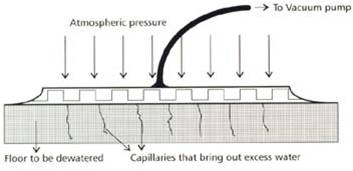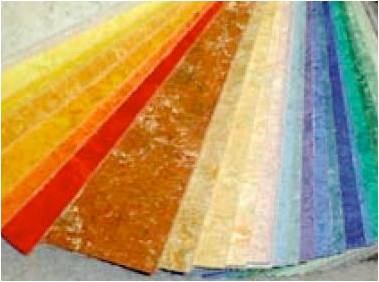- FORUM
- PROJECTS
- ABOUT US
- RESOURCES
- CONTACT US
- FORUM
- PROJECTS
- ABOUT US
- RESOURCES
- CONTACT US
Floor Finish Materials
Flooring like Concrete flooring (Vacuum Dewatered flooring), Terrazzo (marble Chips ) Flooring, Glazed Ceramic Tile, PVC sheet (tile) Flooring ( Vinyl Flooring), Carpet, Marble, Wood – parquet, Mosaic, Timber, Rubber flooring,Linoleum flooring.
Floor Finish
Concrete Flooring (Vacuum Dewatered)
In this system, concrete is poured in place & vibrated with a poker vibrator. Then a screed vibrator is run over the surface, supported on channel shuttering spaced 4.0 meters apart. The screed vibrator is run twice to achieve optimum compaction & leveling. After this a system of lower mats & top mat is laid on the green concrete & this is attached to a vacuum pump. This draws out excess water.

Benefits ov VDF are : Compressive strength of floor increases by up to 60%,Tensile strength increases by @ 70%, Cement consumption is reduced to the extent of 40%, no cement is required separately for finishing the surface, Abrasion resistance of the floor increases by @ 60% resulting in les wear and rear of the floor surface, Shrinkage of concrete is reduced and floor wraps less and Elimination of curling.
Terrazzo Flooring (marble Chips )

Terrazo as in situ and tile floors were once very popular in India and are still being used in middle class houses. However, unless the tiles are made of proper constituents and are well cured, they tend to get pitted. It also requires polishing after it is laid so that enough time should be given at the planning stage itself for its laying with respect to the time of completion of the building.
The Tests for terrazo floor
Absorption test
Abrasion test (resistance to wear)
Transverse strength test on dry tiles
Transverse strength test on tiles after immersion in water for 24 hours
Rubber Flooring

All modern rubber floors are made from synthetic rubber, such as styrene butadiene rubber (SBR). Rubber tiles are cured or vulcanized by the application of heat. Rubber floors are nonporous, waterproof surfaces. One major advantage is that they are quite resilient and will remain resilient over a considerable temperature range.
Rubber flooring is susceptible to alkalines, oils, grease, solvents, ultraviolet light, and ozone in the air. When attacked by these components, a rubber floor will often become tacky and soft. It will then become brittle and begin to crack and powder.
Vinyl Floors (IS 3492-1966)

There are several types of vinyl floorings and tiles. The major varieties include vinyl composition tiles, homogeneous or flexible vinyl tiles, and laminated vinyl flooring.In addition to the vinyl resins, vinyl composition tiles contain mineral fillers such as asphalt and pigments.
Laminated vinyl flooring is less expensive to manufacture than vinyl composition or homogeneous vinyl floors. The low initial cost may be deceiving, however, for once the top wear layer is worn through, the floor will have to be replaced. Some laminated floorings are only guaranteed for three years with moderate use. The cost of laminated vinyl flooring will vary in proportion to the thickness of the top vinyl wear layer.
Cork Tile

Cork tile is made from the outer bark of cork oak trees grown in Spain and Portugal. The cork is ground into large granules, mixed with synthetic resins, and pressed into sheets, which are then cut into tiles. Contemporary cork tiles for floors usually have a top layer of clear vinyl applied to them. This vinyl layer protects the cork from staining and wear.
Cork tiles traditionally have had limited application in industrial or institutional settings. One reason is that cork is susceptible to staining because it is one of the most porous of all floor coverings. Another limitation is that it is not durable; it is highly susceptible to abrasion. Cinders, sand, and gravel tracked on to a cork floor will severely shorten its life span. Finally, it is expensive.
Carpet Floors
Carpet is typically installed wall-to-wall to eliminate the maintenance of hard flooring surfaces around the edge of a carpet. Rugs, on the other hand, are often used to accentuate a tile or wood floor. In areas where there is heavy foot traffic, rugs can be used to equalize wear and help prevent tracking onto other floor coverings.

Carpet offers a number of benefits over hard and resilient flooring materials. Carpet prevents slipping; it provides an additional source of insulation, it has acoustical properties that can effectively lower noise levels; and it is the most resilient of all floor coverings, which is a major benefit to individuals who must remain on their feet for extended periods.
Wood Floors

There is nothing quite as attractive as the warmth and richness of wood floors. Most hardwood floors are made from oak, but other popular woods include ash, beech, birch, hickory, maple, teak, and walnut. In addition to its attractiveness, hardwood floors are extremely durable if they are properly finished and maintained. Unfinished wood floors will quickly deteriorate under even light use, as wood is an extremely porous material.
Unfinished woods are susceptible to dirt lodging in the grains, splintering of the wood fibers, abrasions caused by normal foot traffic, and of course, moisture, the bane of wood floors. Too much moisture will cause a wood floor to warp, while too little humidity will cause wood floors to shrink and crack. To help forestall damage, most wood floors made today receive factory applied finish.
Linoleum (IS 653-1962)

In modern buildings, the use of vinyl has replaced linoleum, but on occasion, linoleum floors can still be found in older facilities. Linoleum was composed of oxidized linseed oil, resins, embedded cork, and wood flour with pigments pressed on a backing.
It is available in rolls of width about 1.80 meters or 3.60 meters. The thickness varies from 2mm to 6mm. Linoleum flooring is also available in form of tiles. Linoleum flooring should be laid over an effective damp-proof area. The negative aspects of linoleum was that it is highly susceptible to water.
Information on this site is purely for education (students / users) purpose. The materials used and displayed on the Sites, including text, photographs, graphics, illustrations and artwork, video, music and sound, and names, logos, IS Codes, are copyrighted items of respective owners. They are provided here just for refrence/information.
For your views and discussions Register in FDAchitects Forum …
1 Comment
Serve me